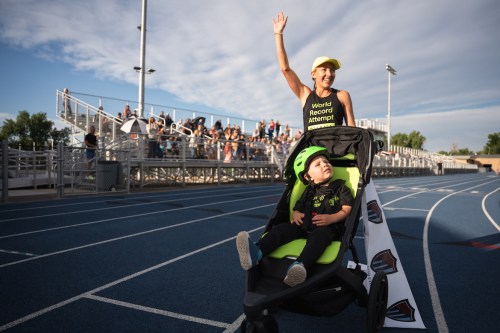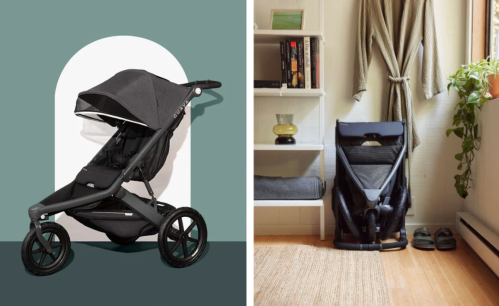Our editors independently select these products. Making a purchase through our links may earn Well+Good a commission
*This* Is How You Should Run With a Stroller, According to the World Record Holder in the Stroller Mile
Discover pro runner Neely Gracey's top tips for stroller running, including the strategies that helped her set the stroller mile record.

Professional runner Neely Gracey regularly runs about 15 to 20 stroller miles a week. It’s not usually about running hard. “It’s just, you know, heading out the door with my kids, doing what we do as a family,” says Gracey.
Experts in This Article
professional long-distance runner, run coach, head of running at Guava Family, and former stroller mile world record holder
But last year, she heard about a man breaking the Guinness World Record for the fastest mile with a stroller. Intrigued, she looked up the women’s record, and realized she’d probably already beaten it just when she was out and about challenging herself for fun. She applied for an official attempt through the Guinness organization, did a few test runs on the track, and on June 30 this year, she set a new world record for the women’s stroller mile in five minutes and 24 seconds with her younger son, Rome, 2, in tow.
Needless to say, Gracey—who is also a run coach, in addition to being a pro runner and a mom to two boys—knows what it takes to effectively run with a stroller. So we recently hopped on a Zoom call and picked her brain to find out what it takes to run your best stroller miles. Here are her top pieces of advice.

1. Invest in a solid running stroller
First things first: To comfortably—and safely—start stroller running, you need to get one that’s designed for the task. Gracey serves as head of running for Guava Family (purveyors of portable gear for parents), and runs with the company’s Roam Stroller ($550), known for its smooth ride and relatively small size when folded up.
Guava Family Roam Stroller — $550.00
Originally $650, on sale for $550
Even though you need to wait until a baby is able to sit on their own with good head control before you can start running with them (typically between six and eight months of age), Gracey recommends having a stroller ready to go before you get home from the hospital. “You can start walks in the stroller right away,” she says. “One thing I found to be so helpful in those early weeks was the ability to get out of the house—it got me fresh air, it got me sunshine. And that is so critical for just how stressful that time can be.”
2. Ease into it
Once your little one is ready for you to pick up the pace, begin gradually. “Start off doing maybe a mile at a time and then adding to two miles, then three so that you’re not overdoing it,” says Gracey.
She warns that you’re going to feel your calves more than usual: “You have to push off a lot harder because you need more force to get the stroller to move.” She found that she would sometimes get sore in her back and neck until she learned to use the right muscles to push the stroller. Speaking of which…
3. Focus on form
Most parents (including Gracey) use stroller runs for easy miles. But that doesn’t mean you should push the stroller in whatever way feels easiest.
“One of the most common things that I notice is people kind of hunch—they lean [over] onto the stroller, and that just totally messes up the whole chain,” says Gracey. “A lot of your power is driven from your hips, from your glutes firing. So you have to keep those underneath your body.” When you push the stroller too far away from your torso and hips, you’re not able to access as much strength in your take off, she says. “So I really focus on running tall, taking smaller steps so that my stride stays underneath me.”
Even when she’s running uphill, Gracey focuses on pushing the handlebar from her latissimus dorsi—the large back muscles beneath our shoulder blades—rather than leaning over and letting the stroller get far away from her body. “The biggest piece of advice is trying to maintain your normal running posture as best you can,” she says, pointing out that, otherwise, you could put extra stress on muscles that aren’t used to it, and end up with overuse injuries.
4. Grab the center of the handlebar
Gracey alternates which hand holds the stroller while she runs, but always grabs the middle of the handlebar so that the stroller stays straight. “You do one hand and then kind of have a more normal arm carriage on [the other] side. And then switch,” she says.
The exceptions? When pushing uphill or around a tight curve, in which case Gracey holds with both hands for maximum control.
5. Figure out what your kids need to stay happy
A stroller run only lasts as long as your passenger allows it to. Gracey found that her first son, Athens, needed constant engagement to stay happy in the stroller. “He needed toys, he needed snacks, he needed games, he needed music, he needed a phone or something to watch,” she says. But Rome is perfectly content just looking around and feeling the motion of the stroller. “Every kid’s different,” says Gracey. Experiment with what works for yours, whether that’s a special treat they only get during a run, or strolls to a park they look forward to playing in.
6. Make it a habit
Part of Gracey’s motivation for setting a world record was to spread the message that your athletic goals don’t have to end once you become a mother. In fact, fitness takes on an extra level of importance: Research shows that children’s activity levels are influenced by how active their mother is.
“It’s really important to bring your kids along, show them the benefits of living an active and healthy lifestyle,” Gracey says. “They get to see that firsthand in a front row seat on the stroller with you.”
Case in point: Now that Athens is five, he loves biking alongside Gracey as she runs with Rome in the stroller. “It feels so good to be able to do that as a family,” she says.
Sign up for the Well+Good SHOP Newsletter
Get exclusive deals on wellness, beauty, fitness, and food products that have been hand-picked by our editors.
Got it, you've been added to our email list.








